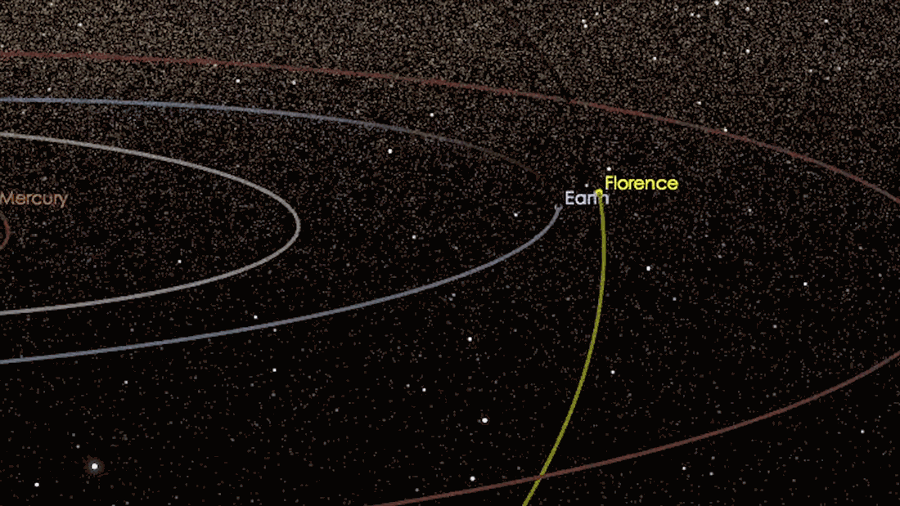NASA announced that an asteroid would pass close to Earth on September 1. However, it won’t represent any risk for humanity. Florence – named after the celebrated British medic Florence Nightingale and considered the largest asteroid that passes near to our planet since NASA started recording asteroids’ courses – will be passing within a distance of 4.4 million miles from the Earth, or 7 million kilometers, at 8:05 a.m. ET, according to NASA.
According to Universe Today, North America will be able to look Florence at about 60 degrees above the southern horizon. Although it will be visible on Thursday, people will see it better on Friday. The very same day, people also in the Pacific Rim, including Australia, New Zealand, and surrounding regions, will be able to visualize Florence.

Researchers estimate that Florence measures 2.7 miles wide. An asteroid of that size and magnitude would represent a massive disaster for humanity. According to Near Earth Objects, Florence would kill around 1.5 billion people if it collided with the Earth, without mentioning the many earthquakes or tsunamis it would generate in our home planet. However, NASA has assured Florence won’t make any huge difference in most of our lives. To watch it, people need certain specialized equipment – like a telescope -, which is why it will probably pass unnoticed for many of us.
Despite Florence passing very close from us, this is not the first asteroid that reaches that kind of distance. There have been many others, even coming near Earth’s atmosphere. However, none of them have been so big, and NASA still considers that 4.4 million miles is very, very close.
Considering how large the space is, there could be millions of other asteroids even bigger. That’s why scientists consider it important to study Florence. There’s still about 1,400 other objects floating in the space, and the chances for them to reach our planet are minuscule. The chances that one of them colliding with us are around 0.0002 percent and the chances of an event similar to what killed dinosaurs many years ago are even smaller.
“Certainly not for the next several centuries, and not likely over the next many millennia either,” said in a statement Paul Chodas, manager of NASA’s Center for Near-Earth Object Studies. “It’s possible this asteroid could threaten our planet in the far distant future, but it’s unlikely.”
Researchers will seize the opportunity to study Florence
Researchers estimate Florence measures around 2.7 miles wide. It is the first time an asteroid this large passes so close to our Earth since 1890, and it won’t happen again at least until 2500, according to NASA. The agency believes that any object larger than half-mile to a mile (one to two kilometers) passing near us should be studied due to the catastrophic effects that they might produce if they collided against us.
According to Chodas, researchers will take images of Florence to study the asteroid’s composition, shape, surface properties, roughness and the presence of boulders, as well as if it has any satellites surrounding it. These pictures will be taken by the Goldstone Solar System Radar in California and the National Science Foundation’s Arecibo Observatory in Puerto Rico.
Of course, it’s much easier for the space agency to study an asteroid passing this close than another that is millions of miles away. However, there’s a NASA mission named OSIRIS-Rex, which launched in September 2016 and is collecting samples of an asteroid called Bennu, which has a lot of chances to be dangerous for the Earth.

“It will be gliding northward by a little less than the full Moon’s diameter each hour, motion that should be obvious by watching the asteroid’s starlike pinpoint through a telescope for just a few minutes,” according to a Sky & Telescope statement.
Despite the fact that no asteroids will hit the Earth –at least not this century -, scientists are worried about studying them because there’s still a tiny chance for them to collide with our planet.
At this moment, the world is underprepared for an asteroid collision. Perhaps it is not possible to save all humans, but there are already a few ideas in case of something like that ever happens.
Right now, a possible way to avoid an asteroid collision is to generate an explosion so big that it makes the asteroid disappear. However, this might result in millions of tiny asteroids surrounding the Earth.
Another theory is to slow down and change the trajectory of the asteroid. This would represent a bigger challenge but would be more effective.
Source: Universe Today
